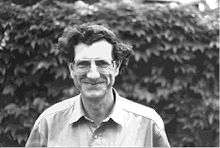Didier Astruc
| Didier Astruc | |
|---|---|
 Professor Didier Astruc | |
| Born | Versailles, France |
| Residence | France |
| Nationality | French |
| Fields | Chemistry, Dendrimers |
| Institutions | University Bordeaux |
| Doctoral advisor | R. Dabard |
Didier Astruc (born in Versailles) carried out his studies in chemistry in Rennes. After a Ph. D. with professor R. Dabard in organometallic chemistry, he did post-doctoral studies with professor R. R. Schrock (2005 Nobel Laureate) at the Massachusetts Institute of Technology Cambridge, Mass., in the U.S. and later a sabbatical year with professor K. P. C. Vollhardt[1] at the University of California at Berkeley. He became a CNRS Director of research in Rennes, then in 1983 full Professor of Chemistry at the University Bordeaux 1. He is known for his work on “Electron-Reservoir” complexes[2] and dendritic molecular batteries,[3] catalytic processes (olefin metathesis,[4] C-C coupling,[5] catalysis in water)[6] using nanoreactors and molecular recognition using gold nanoparticles[7] and metallodendrimers.[8] He is the author of three books, scientific publications and the editor of five books or special issues. He has been a member of the National CNRS committee from 2000 to 2008 and the President of the Coordination Chemistry Division of the Société Française de Chimie from 2000 to 2004. Didier Astruc is on the Thompson-Reuters list of the top 100 chemists who have achieved the highest citation impact scores for their chemistry papers published between 2000 and 2010.[9] and on the Thomson-Reuters list of the Highest Cited Researchers 2015 and 2016.[10]
Distinctions
- Prize of the Teaching Division of the French Chemical Society (2016)
- Distinguished Member of the French Chemical Society (2015)
- Member of the National Committee for UNESCO (2012).
- Member of the European Academy of Sciences and Arts (2010).
- Recipient of the Gold Medal of the Italian Chemical Societies and joint Prize of the Italian and French Chemical Societies (2009).
- Karl Friedrich Gauss Professor of the University of Göttingen (2008).
- Member of the European Academy of Sciences (2007).
- Member of the Academia Europaea (2006).
- Member of the Leopoldina Academy, German Academy of Sciences (2006).
- Fellow of the Royal Society of Chemistry (2005).
- Grand Prix Achille Le Bel of the French Chemical Society (2001).
- Iberdrola Prize (1995).
- Senior Member of the Institut Universitaire de France (1995–2005).
- German-French Humboldt Award (Fondation Alexander von Humboldt) (1989).
- Prize of the Coordination Chemistry Division of the French Chemical Society (1981).
External links
- Homepage of Profesor Didier Astruc
- Nanoparticles and Catalysis edited by Didier Astruc
- A special issue of the review "Inorganic and Organometallic Polymers and Materials" (Springer) dedicated to Professor Didier Astruc appeared in January 2008
- The 100 most cited chemists for articles published between 2000 and 2010
References
- ↑
- ↑ D. Astruc, Electron Transfer and Radical Processes in Transition-Metal Chemistry, VCH, New York, 1995 (630 pp., preface by Henry Taube).
- ↑ C. Ornelas; J. Ruiz; C. Belin; D. Astruc. (2009). "Giant Dendritic Molecular Electrochrome Batteries with Ferrocenyl and Pentamethylferrocenyl Termini.". J. Am. Chem. Soc. 131: 590–601. doi:10.1021/ja8062343.
- ↑ C. Ornelas; D. Méry; E. Cloutet; J. Ruiz; D. Astruc. (2008). "Cross Olefin Metathesis for the Selective Functionalization, Ferrocenylation, and Solubilization in Water of Olefin-Terminated Dendrimers, Polymers, and Gold Nanoparticles and for a Divergent Dendrimer Construction.". J. Am. Chem. Soc. 130: 1495–1506. doi:10.1021/ja077392v.
- ↑ A. K. Diallo; C. Ornelas; L. Salmon; J. Ruiz; D. Astruc (2007). ""Homeopathic" Catalytic Activity and Atom-Leaching Mechanism in Miyaura–Suzuki Reactions under Ambient Conditions with Precise Dendrimer-Stabilized Pd Nanoparticles.". Angewandte Chemie International Edition. 46: 8644–8648. doi:10.1002/anie.200703067.
- ↑ D. Astruc, Organometallic chemistry and catalysis, 608 pp. Springer, Berlin, 2007.
- ↑ E. Boisselier; A. K. Diallo; L. Salmon; C. Ornelas; J. Ruiz; D. Astruc. (2010). "Encapsulation and Stabilization of Gold Nanoparticles with "Click" Polyethyleneglycol Dendrimers.". J. Am. Chem. Soc. 132: 2729–2742. doi:10.1021/ja909133f.
- ↑ D. Astruc; E. Boisselier; C. Ornelas (2010). "Dendrimers Designed for Functions: From Physical, Photophysical, and Supramolecular Properties to Applications in Sensing, Catalysis, Molecular Electronics, and Nanomedicine". Chem. Rev. 110: 1857–1959. doi:10.1021/cr900327d. PMID 20356105.
- ↑ sciencewatch link
- ↑ sciencewatch link
- ↑ Didier Astruc. (2012). "Electron-transfer processes in dendrimers and their implication in biology, catalysis, sensing and nanotechnology". Nature Chemistry. 4: 255–267. doi:10.1038/nchem.1304.
- ↑ C. Wang, R. Ciganda, L. Salmon, D. Gregurec, J. Irigoyen, S. Moya, J. Ruiz, D. Astruc (2016). "Highly efficient transition metal nanoparticle catalysts in aqueous solutions.". Angew. Chem. Int. Ed. 55: 3091–3095. doi:10.1002/anie.201511305.
- ↑ X. Liu, D. Gregurec, J. Irigoyen, A. Martinez, S. Moya, R. Ciganda, P. Hermange, J. Ruiz, D. Astruc (2016). "Precise Localization of Metal Nanoparticles in Dendrimer Nanosnakes or Inner Periphery and Consequences in Catalysis.". Nat. Commun. 7: 13152. doi:10.1038/ncomms13152.
